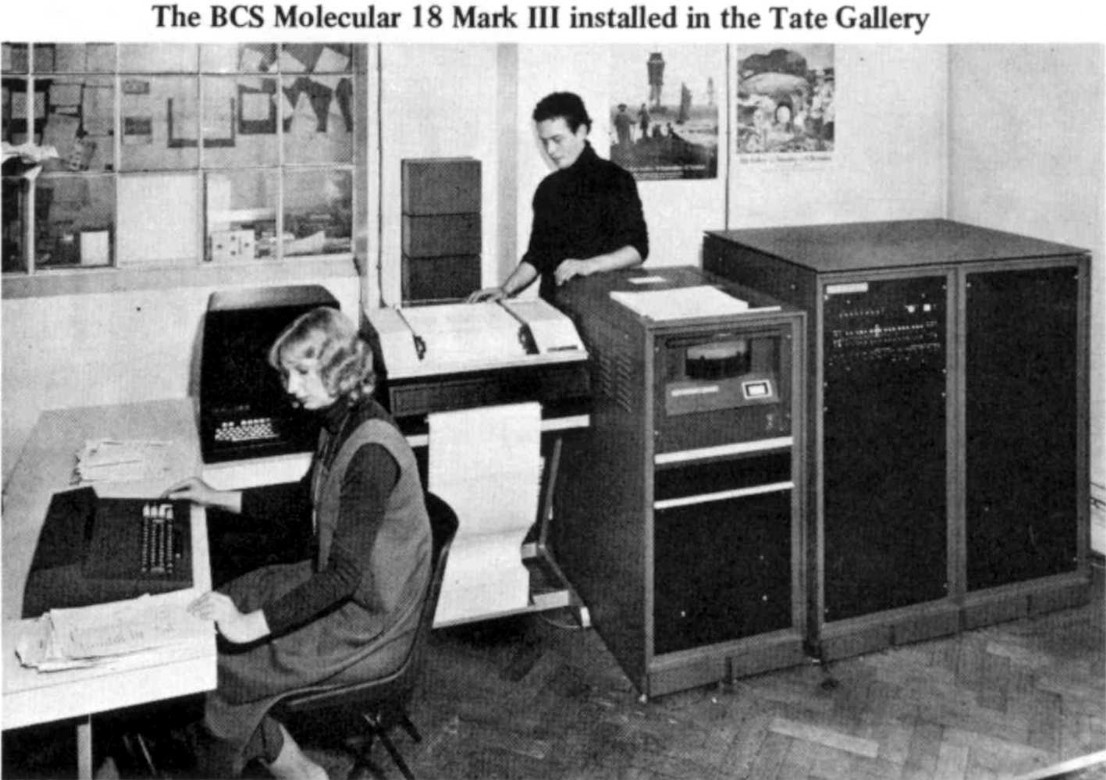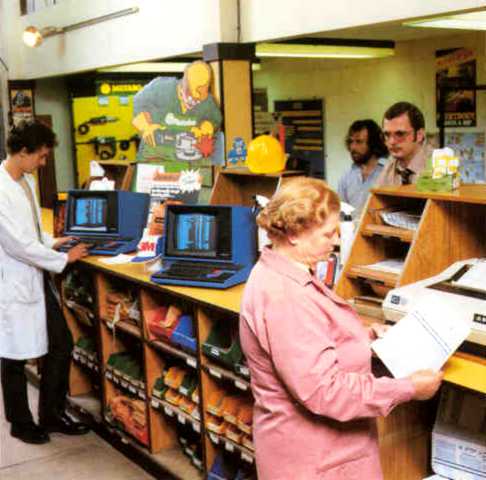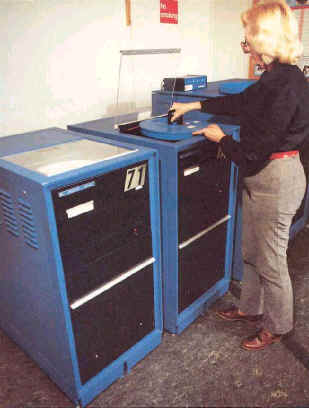The Tate Gallery
One of the most important activities of the Tate Gallery, representing an annual turnover of half a million pounds, is its sales of reproductions of its art collection. The problems of stock control and accounting became so great that the Gallery has now installed a small business system.
A typical example of a direct entry mini computer system which provides sales accounting and stock control routines and with the facility for on-line enquiries is the BCL MOLECULAR computer in the Publications Department of the Tate Gallery.
The upsurge of public interest in art has resulted in an extensive business being built up in the sales of reproductions of the vast art collection administered by the Tate. The Publications Department generates an annual turnover of £500,000 from over 2,500 different products which are distributed throughout the UK and overseas.
To ensure effective stock control of their 2,500 different product lines and efficient sales accounting procedures they use a MOLECULAR minicomputer system supplied by Business Computers (Systems) Limited, which consists of a 12K words central processor, alpha numeric display keyboard, 200 lpm printer, visual display terminal and 5 million characters of disc storage and is basically designed to cater for a wide range of accounting functions, stock control and generation of sales and management reports.
The products marketed by the Tate fall into 12 main groups and range from framed reproductions, reference books and exhibition catalogues, to photographic slides and art post cards. More than one million of these post cards are supplied each year to the Tate’s 500 account customers, through the retail shop housed within the Gallery, and by mail order to overseas.
Supplies of stocks are held at two locations, a bulk warehouse in Cambridgeshire and in a large in-house stock room to meet day to day requirements. Customer account details, product information and stock levels, detailing separate levels for the two locations, are held on disc files.
Order data is input to the system through the keyboard or the VDU, although the latter in this instance is mainly used for customer account and stock interrogation. Under program control, the keyboard operator is guided through each step of invoicing procedure, thus reducing the possibility of errors.
Relevant customer details are entered, quantity of items required and the system completes the invoice line showing total value and VAT. Four price categories, cost, retail, trade and educational for each stock item are catered for within the system.
Stock is immediately updated on completion of each invoice line thus providing up to the minute stock accuracy to satisfy customer telephone enquiries. If, however, the invoice is cancelled for any reason, stocks are immediately returned to their correct levels. The flexibility of the system allows invoices to be printed as a simultaneous operation of keyboard input or, if the printer is being used for report production, spooled on disc for later processing. During invoice printout customer balances, master files by product group, customer sales by product group and profit by product group, are automatically updated.
On-line enquiries, such as stock levels and customer account details showing current balance and aged debt analysis over thirty, sixty and ninety days can be carried out without interrupting the progress of other work systems being processed by the installation.
Batch reports and cash posting are carried out daily. Cash posted to customer accounts is allocated to the relevant aged debt category and balances updated. A variety of reports are catered for to provide vital sales statistics.
Aged debt analysis reports for distribution to key departments are produced on a regular basis to ensure efficient cash flow.
The system which was operational within one week of installation uses standard BCL software, although modifications have been implemented in-house by Mr Mark Adams, computer controller at the Tate. These include refinements to ease the task of producing repetitive invoices which result from volume requests for catalogues during an exhibition of national appeal.
Previously a BCL Susie accounting machine was used but as work loads increased this was replaced by the Molecular system which is capable of expansion with the addition of peripherals and added processor capacity to meet future business expansion without changing hardware or software.
"We chose the system" said Mr Brian McGahan the department assistant Manager, "because of its ease of operation and capabilities for future expansion, should these be required by increased workloads. The direct entry and on-line enquiry facilities provided by the system are ideal for our operation and allow us to maintain stock at optimum levels and keep rigid control of our cash flow position which is vital in these days of high interest rates".
Published in DATA SYSTEMS (February 1977)

Jackdaw Tool Merchants
Moving Into the Computer Age
"PREPARATION IS HARD WORK BUT NOW THE BENEFITS ARE TREMENDOUS"
The decision to incorporate a computer system into their products and processes is one that most distributors are having to face at some time or another. ED spoke to Jackdaw Listers (Tools) Ltd, of Leveson Street, Willenhall, West Midlands, an AED member and a business which is typical of many companies engaged in the distribution of engineers’ supplies to industry. In this article Mr Gordon Pearson, managing director discusses how his company tackled the project, and what it entailed.
It was in 1979 that Jackdaw Listers (Tools) started thinking about a computer. The company was profitable but if it wished to continue that way it was apparent to the directors that a move into computerisation was necessary, says Cordon Pearson.
Nobody in the company had any prior knowledge of computers. In 1978/79 the company employed a total of fifty-five people and on manual operation they had got it down to forty-four, which was the minimum they could hope for without recourse to computer operation. Now the employees number twenty-two on the merchant side including three representatives, a reduction achieved by natural wastage, and no extra staff have been needed to operate the system. "Everyone uses it quite happily", says Mr Pearson.
Incorporated into the system is an associate company, Jackdaw (Fasteners) Ltd, with fifteen employees, who are manufacturers and distributors of fasteners. It occupies nearby premises and has common administration.
At the start Mr Pearson and the company secretary looked at many systems over the course of a year, and ended with a short list of three systems. They did this by demanding certain requirements. The supplier had to take them to a user similar to themselves and they had to be left alone to talk with him. "It is essential to see other users", says Mr Pearson.
The company which filled these provisions was Business Computer Systems plc, of Borehamwood, Herts with branch offices at six other locations.
This company had a distribution system which had proved itself in similar businesses and it was in a position to take Jackdaw Listers (Tools) to see these in operation. BCL provided a totally integrated package which offers all the facilities one would expect, such as sales ledger, purchase and nominal ledgers and payroll and in the key operating areas of a merchant involved in wholesale distribution, such as stock control, fast order processing, buying control, price and discount information and instant and accurate management information.
"It seemed to be the system we wanted", says Mr Pearson. Accordingly the company decided on a 40k processor (40,000 words of storage), one disc drive, eight VDUs and three printers. More VDUs have been added since to make a total of eleven throughout the building and the capacity has been increased from 40k to 48k.
Space for the equipment was no problem. Only a small room was needed and this involved a minimal cost.
It was then that the hard work started, says Mr Pearson. Stock numbering and binning started in February 1981 and the management and staff put in a lot of overtime and weekends. "We had months of hard talking on the question of when and how".
The equipment arrived at the beginning of March and the system went "live" in June, five months of preparation all told. The company switched from manual on Friday and started on computer on Monday. All the staff had been fully instructed and were fully receptive to the new working. BCL did the programming.
Mr Pearson feels that the whole psychology of the business has changed for the better. The staff found their jobs more interesting and instant information was at their fingertips. Enquiries at the trade counter or on the telephone get immediate answers.
A perpetual stock inventory is provided, along with information on prices and discounts, credit standing of customers, sets of picking documents and ready invoices, all with less errors.
Savings have been made on postage and handling and there has been no increase in stationery costs. Sales can be increased on a lower stock holding.
Labour saving has been tremendous, says Mr Pearson and the speed of working is "devastating". The company still uses Luckin's price reporter service to update prices and one girl can do this on Monday in thirty minutes.
And the cost? Mr Pearson gave a figure of £70,000 all told which came out of their own profitability with one hundred per cent allowances. He says that they are looking at the system all the time to make the most of it and to update it.
The computer has become an every day part of working life, with a VDU at the elbow of virtually every employee in Jackdaw Listers (Tools) Ltd.
It is now Jackdaw Listers (Tools) turn to be visited by similar firms looking at computers for the first time. The company accepts about two visits a month, but Mr Pearson feels it provides a useful exchange of ideas.
REPRINTED FROM ENGINEERING DISTRIBUTOR MARCH 1983

Philip Harris Medical
Maggie arrives!
Philip Harris Medical’s Molly was delivered around the time Margaret Thatcher became Leader of the Opposition (1977?) so it was promptly named Maggie. Here indeed was an Iron Maiden, and painted blue. There were to be six VDUs (four for the telesales office) and two printers (one for directly printing invoices in the warehouse). After some weeks gestation while we developed the programs at Leicester and PHM checked them out very thoroughly and prepared themselves, LOS was born when PHM opened for business, "live" on Maggie on the first Monday of November in that year.
Anne McGrory and myself (Joe Templeman) were in attendance with Kath (Hodges), Mr Ruston (the MD) and other managers standing by behind the telesales girls as they began their calling rota. It was a revelation! No Molly had ever had the opportunity to show but a fraction of what it could do until that morning. I went through to watch Maggie. Yes, her lights were flickering. Instructions were being fetched and executed, for a real purpose now. Interrupts were being taken from all quarters and dismissed methodically. Drive belts were staying on and propelling the disc cartridges at the proper speed and the head access mechanisms were wild with frenzied yet directed activity. Power supplies were pumping energy at the correct voltages into the circuits. Down in the warehouse the printer was disgorging real invoices, the shelves were being picked of goods and the delivery vans were rolling. How long could it last? To me, every extra second was another million or so crash possibilities negotiated. There are advantages, in this situation, in not being aware of what could go wrong. So my frequent calls to Kath to "take a security" were cast aside until things quietened down at lunchtime. I could relax a bit after we’d secured the mornings work.
As other companies were to discover in their turn, the whole atmosphere of the business was transformed the instant their Molly went into action. It was there to help, not to intimidate. This atmosphere was subtle but tangible whenever I entered a building containing a LOS Molly. Mind you, a certain tool distributor did keep their entire stock of sledgehammers just outside the door to their Molly - just in case?
A significant component missing from LOS on that first day was any means to deal with a paper wreck at the invoice printer. This was because I didn’t have a clue how the situation could be handled, until it happened. That occurred soon enough, and the document reprinting utility was soon operational.
Maggie and Denis in 1990
By 1990 Maggie was bulging with the maximum 64K words of memory and the interfaces to serve 17 VDUs and 5 printers, and now backed up by a second Molecular (named Denis, after Mr Thatcher). Even though the processor still ran at the same speed as in 1976, no realistic UNIX alternative could yet match the performance of the machine code applications software. However, hardware breakdowns were a constant anxiety which Denis could only partially mitigate, so a reliable UNIX alternative was being sought. It became a close race as to which of the two Maggies would outlast the other in office. In the end, Maggie the Molecular had a narrowly longer run.
Though Maggie's electronic circuits remained 1970s technology, and her on-line storage capacity never rose above the original 13 megabytes, the emergence of microcomputers (followed by Personal Computers or PCs) in the 1980s provided her a lifeline to capabilities she could not hope to offer unaided. Plugging one of these into her in place of a "dumb" VDU enabled her to transfer data with the emerging networks, to download to high-capacity archival storage, and even gave her an accurate clock.
Joe Templeman


